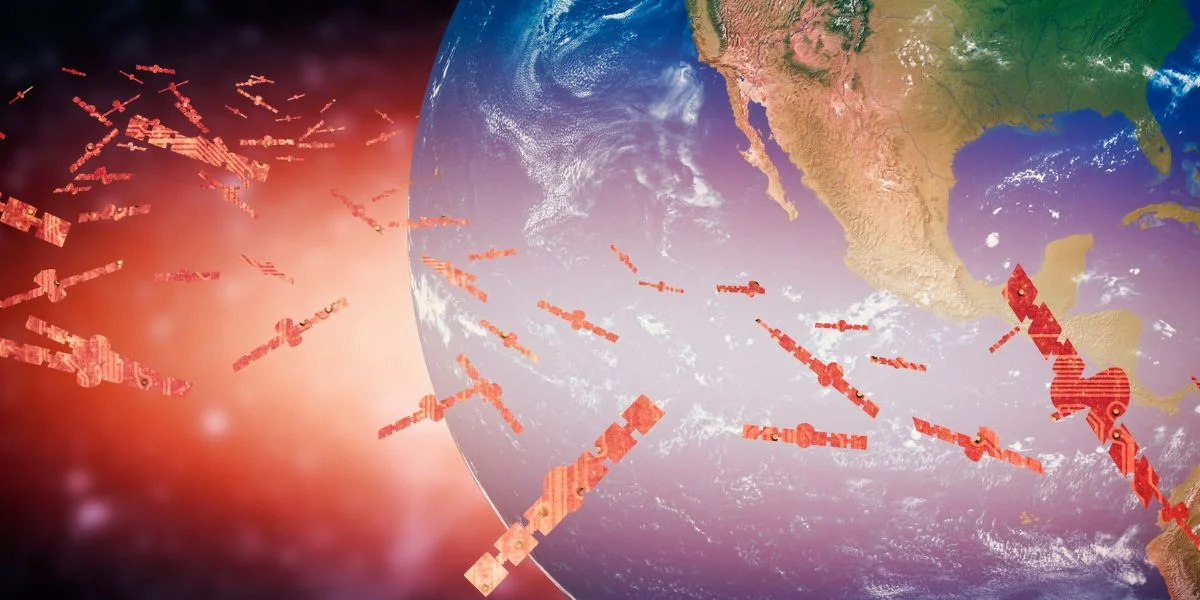
Space debris, often referred to as ‘space junk,’ encompasses a multitude of defunct satellites, discarded rocket stages, fragments from past collisions, and other man-made objects that orbit our planet. These remnants of human space exploration now form a growing cloud of debris encircling Earth, posing unique challenges and risks to both existing and future space activities.
One of the primary concerns is the potential for collisions with operational satellites and spacecraft. Even small pieces of debris traveling at high velocities can cause significant damage. This not only jeopardizes the functionality of vital communication and Earth-monitoring satellites but also increases the risk to astronauts aboard the International Space Station (ISS).
Moreover, as space junk accumulates over time, the situation can become self-perpetuating. Collisions between existing debris generate more fragments, creating a cascading effect known as the Kessler syndrome. This can potentially render certain orbits unusable and exacerbate the challenges of space traffic management.
Addressing the issue of space debris requires international cooperation and innovative solutions. Tracking and monitoring space trash is essential to predict potential collisions and protect operational assets. Furthermore, efforts to remove or deorbit defunct satellites and large fragments are crucial to mitigating the problem.
What is Space Debris?
Space debris comprises defunct human-made objects and fragments in Earth’s orbit. It includes large items like defunct satellites and rocket stages, smaller fragments, and medium-sized debris. Geostationary orbit and low Earth orbit (LEO) are areas of concern due to their crowded nature.
LEO, below 2,000 kilometers, hosts many operational satellites and the ISS, making it susceptible to collisions. Objects in geostationary orbits, around 35,786 kilometers, pose risks to communication satellites. Polar orbits, passing over the poles, are used for Earth observation but also contain debris.
Fragmentation debris results from collisions or explosions, generating more fragments. Debris can be cataloged (actively tracked) or uncatalogued (too small or lost from databases).
The Growing Threat of Space Junk Orbiting Earth
The exponential increase in space debris results from several factors:
Launches: The continuous launch of satellites and missions into space adds more objects to Earth’s orbit. While some satellites are actively managed and deorbited, others remain in orbit as defunct debris.
Fragmentation: Collisions or explosions in space generate smaller fragments, contributing to the overall debris population. These events create a cascading effect, known as the Kessler syndrome, where debris begets more debris.
Lack of Regulations: Historically, there were no strict regulations on the disposal of defunct satellites and rocket stages. This resulted in a proliferation of uncontrolled debris.
Longevity: Objects in space can remain in orbit for many years or even decades, compounding the debris problem over time.
Dangers to Operational Satellites and Spacecraft:
Space debris poses significant dangers to operational assets in Earth’s orbit:
Collision Risks: Debris travels at extremely high velocities, making even small fragments capable of causing significant damage upon impact. Collisions with operational satellites or spacecraft can lead to the loss of valuable assets.
Spacecraft Safety: The International Space Station (ISS) and crewed missions are at risk from space junk orbiting earth. Evacuating astronauts in the event of an impending collision is a challenging and time-sensitive operation.
Orbital Pollution: Excessive debris in certain orbits can render them unusable for future missions or satellite deployments, limiting the available space for new ventures.
Specific Incidents and Risks of Space Trash:
Iridium 33 and Cosmos 2251 Collision (2009): One of the most notable incidents occurred when the operational Iridium 33 satellite collided with the defunct Cosmos 2251 satellite. This collision produced thousands of trackable fragments and highlighted the grave risks posed by space debris.
Chinese ASAT Test (2007): China’s anti-satellite (ASAT) test created a substantial amount of debris when a missile destroyed an old weather satellite. This event significantly contributed to the debris problem and raised international concerns.
Near-Miss Incidents: Numerous near-miss incidents between space debris and operational satellites have occurred, requiring last-minute adjustments to satellite orbits to avoid collisions.
Tracking and Monitoring
Space agencies and organizations worldwide have implemented extensive efforts to track and monitor space debris to mitigate associated risks. They employ advanced technology and methods for this crucial task.
Technology and Methods: Tracking space debris involves radar systems, optical telescopes, and specialized sensors on satellites. Ground-based radar helps determine the location, size, and trajectory of debris. Optical telescopes capture images for identification. Satellites in orbit equipped with sensors can provide real-time data on nearby debris. Sophisticated software processes this information, predicting debris movement.
Mitigating Risks: Tracking and monitoring space debris play a pivotal role in risk mitigation. They allow space agencies to:
Collision Avoidance: By accurately tracking debris, space agencies can predict potential collisions and instruct operational satellites or the ISS to adjust their orbits to avoid them.
Space Traffic Management: Data on debris locations and trajectories enable space traffic management, ensuring safe routes for launches and satellite deployments.
Satellite Design: Information on debris sizes and velocities informs satellite design to enhance their resilience to potential impacts.
Debris Removal: Agencies use tracking data to plan debris removal missions, such as capturing defunct satellites or large fragments and deorbiting them to reduce the overall debris population.
Mitigation and Cleanup
Mitigating space debris involves multiple strategies:
Satellite Design: Implementing design guidelines for satellites, including shields or maneuverability to avoid collisions, can reduce the creation of new debris.
Active Removal: Proposed methods for debris removal include harpoons, nets, and robotic arms to capture and deorbit defunct satellites or large fragments.
International Cooperation
International cooperation is crucial for effectively addressing the space debris issue. The global nature of space exploration means that actions by one country can impact others. Collaborative efforts ensure shared responsibility and prevent further exacerbation of the problem. Various agreements and guidelines, such as the Outer Space Treaty and the Space Debris Mitigation Guidelines by the United Nations, provide a framework for responsible space activities. Initiatives like the Inter-Agency Space Debris Coordination Committee (IADC) promote data sharing and best practices. These international efforts foster transparency, reduce the risk of collisions, and promote sustainable and safe space exploration for all nations.
Future of Space Debris
Future space debris management faces challenges as space activities grow. Trends include:
Increasing Satellites: A surge in satellite deployments for communication and Earth observation will intensify the debris issue.
Emerging Space Players: New spacefaring nations may lack experience in responsible debris mitigation.
Active Debris Removal: Advancements in technologies for capturing and removing debris are being developed but remain costly.
Sustainability Initiatives: Efforts to design satellites for deorbit and reduce space debris generation will become more common.
Lunar and Deep Space Missions: Expanding exploration beyond Earth orbit will raise concerns about debris management in these regions.
Conclusion
Space debris poses a growing threat to our space environment, emphasizing the urgent need for ongoing efforts to ensure its sustainability and safety. International cooperation, backed by agreements and guidelines, plays a pivotal role in mitigating this problem. The development of technologies for active debris removal offers hope for reducing the clutter in orbit. However, as we embark on lunar missions and expand deep space exploration ambitions, future challenges will shape the space debris landscape. It’s vital for all stakeholders to stay informed, support responsible space practices, and collaborate to preserve a sustainable and secure space environment for present and future generat




Leave a Reply